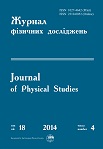Journal of Physical Studies 23(4), Article 4902 [10 pages] (2019)
DOI: https://doi.org/10.30970/jps.23.4902
PHYSICAL CONDITIONS IN M6.4/3N SOLAR FLARE OF 19 JULY 2000
V. G. Lozitsky1, M. I. Stodilka{2}
1Astronomical Observatory of the Taras Shevchenko National University of Kyiv,
3, Observatorna St., Kyiv, Ukraine
2Astronomical Observatory of the Ivan Franko National University of Lviv,
8, Kyryla i Mefodiya St., Lviv, Ukraine
|
 |
We investigate the solar flare on July 19, 2000 of M6.4/3N class, which arose in the active region NOAA 9087. Echelle Zeeman spectrograms of this flare were obtained at the horizontal solar telescope of the Astronomical Observatory of the Taras Shevchenko National University of Kyiv. The effective magnetic field $B_{\rm eff}$ was measured using spectral lines FeI 6301.5, FeI 6302.5 and ${\rm H}_\beta$. It turned out that in the brightest place of the flare, which was projected onto a small sunspot of N magnetic polarity, $B_{\rm eff}$ by all three above-named lines are close to each other and correspond to 1.0-1.2 kG. At the same time, the module of magnetic field strength at the level of formation of FeI 6302.5 was within the range of 1.6-2.6 kG. The features of the bisectors of $I\pm V$ profiles of FeI 6301.5 line indicate a simple one-component magnetic field structure at the level of the middle photosphere under the flare. The semi-empirical model of the photospheric layers was constructed on the basis of the observational profiles of Stokes $I$ of Fe I 5123.7 and 5434.5 lines by solving the inverse problem of non-equilibrium transfer of radiation using Tikhonov's stabilizers. It turned out that for the temperature distribution with height, the deviation from the LTE is already significant for the layers of the lower photosphere corresponding to the heights $h\geq0$ (that is, $\tau_5\leq1$). In the entire thickness of the photosphere ($h=0-500$ km), the temperature in the flare is lowered compared to the undisturbed atmosphere, whereas for $h>500$ km it is slightly elevated. The microturbulent velocity is raised at altitudes of $h=200-500$ km, while at altitudes of $h<200$ km it is lowered. The obtained results indicate that the upper photosphere and the lower chromosphere are significantly disturbed during a solar flare, even when the magnetic field in the lower layers (the middle photosphere) is quasi-homogeneous.
PACS number(s): 96.60.Hv, 96.60.Q-, 96.60.qe
pdf
References
- V. G. Lozitsky, E. A. Baranovsky, N. I. Lozitska, U. M. Leiko, Solar Phys. 191, 171 (2000);
CrossRef
- V. G. Lozitsky, Astron. Lett. 35, 136 (2009);
CrossRef
- E. V. Kurochka, V. G. Lozitsky, Kinem. Phys. Nebes. Tel, Suppl. 21, 143 (2005).
- E. V. Kurochka, V. G. Lozitsky, O. B. Osyka, Kinem. Phys. Celest. Bodies 24, 308 (2008);
CrossRef
- V. I. Abramenko, E. A. Baranovsky, Solar Phys. 220, 81 (2004);
CrossRef
- E. S. Andriets, N. N. Kondrashova, E. V. Kurochka, V. G. Lozitsky, Bull. Crimean Astrophys. Observ. 108, 1 (2012);
CrossRef
- E. A. Baranovsky, V. G. Lozitsky, V. P. Tarashchuk, Kinem. Phys. Celest. Bodies 25, 373 (2009);
CrossRef
- E. H. Avrett, R. Loeser, SAO Spec. Rep. 303 (1969).
- B. Ruiz Cobo, J. C. del Toro Iniesta, Astrophys. J. 398, 375 (1992);
CrossRef
- H. Socas-Navarro, Astrophys. J. Suppl. Ser. 169, 439 (2007);
CrossRef
- A. Cristaldi, I. Ermolli, Astrophys. J. 841, 115 (2017);
CrossRef
- J. de la Cruz Rodríguez, J. Leenaarts, A. Asensio Ramos, Astrophys. J. Lett. 830, 30 (2016);
CrossRef
- M. I. Stodilka, Kinem. Fiz. Nebes. Tel 19, 334 (2003).
- V. G. Lozitsky, Adv. Space Res. 57, 398 (2016);
CrossRef
- S. Tsuneta et al., Solar Phys. 249, 167 (2008);
CrossRef
- Ch. E. Moore, M. G. J. Minnaert, J. Houtgast, The spectrum 2935 A to 8770 A. Second revision of Rowland's Table of solar spectrum wave lengths (National Bureau of Standards, Washington, DC, 1966).
- E. L. Landi Degl'Innocenti, Solar Phys. 77, 285 (1982);
CrossRef
- E. N. Zemanek, A. P. Stefanov, Vestnik Kiev Univ. Ser. Astron. 18, 20 (1976).
- J. O. Stenflo, Solar Phys. 32, 41 (1973);
CrossRef
- I. Dominguez Cerdena, J. Sanches Almeida, F. Kneer, Astron. Astrophys. 407, 741 (2003);
CrossRef
- D. N. Rachkovsky, T. T. Tsap, V. G. Lozitsky, J. Astrophys. Astron. 26, 1 (2005);
CrossRef
- V. G. Lozitsky, E. A. Baranovsky, N. I. Lozitska, V. P. Tarashchuk, Mon. Not. Roy. Astron. Soc. 477, 2796 (2018);
CrossRef
- V. G. Lozitsky, J. Staude, J. Astrophys. Astron. 29, 387 (2009);
CrossRef
- N. I. Lozitska, et al., Adv. Space Res. 55, 897 (2015);
CrossRef
- H. Socas-Navarro, B. Ruiz Cobo, J. Trujillo Bueno, Astrophys. J. 507, 470 (1998);
CrossRef
- M. Asplund, A. Nordlund, R. Trampedach, C. Allende Prieto, R. F. Stein, Astron. Astrophys. 359, 729 (2000).
- J. E. Vernazza, E. H. Avrett, R. Loeser, Astrophys. J. Suppl. Ser. 45, 635 (1981);
CrossRef
- P. Maltby et al., Astrophys. J. 306, 284 (1986);
CrossRef
- M. Schussler, A. Vogler, Astrophys. J. 641, 73 (2006);
CrossRef
- M. Rempel, M. Schussler, M. Knolker, Astrophys. J. 691, 640 (2009);
CrossRef
- Ch. Cowley, The Theory of Stellar Spectra (Gordon and Breach Science Publishers, New York--London--Paris, 1970).
- Э. А. Гуртовенко, Р. И. Костик, Фраунгоферов спектр и система солнечных сил осцилляторов (Наукова думка, Киев, 1989).
- E. N. Parker, Astrophys. J. 234, 333 (1979);
CrossRef
- H. C. Spruit, in Proceedings of the Conference "The Physics of Sunspots" (Sacramento Peak Observatory, New Mexico, 1981), p. 98.
- A. R. Choudhuri, NATO ASIC Proc. 375: Sunspots. Theory and Observations, edited by J. H. Thomas, N. O. Weiss (Kluwer Academic Publisher, 1992).
- J. Joshi, PhD Thesis, Techn. Universitat Braunschweig (Germany, 2014). %ISBN 978-3- 944072-01-2
- A. Cristaldi et al., Astrophys. J. 789, 162 (2014);
CrossRef
- P. Gomory et al., Astron. Astrophys. 602, 60 (2017);
CrossRef
- J. J. Sudol, J. W. Harvey, Astrophys. J. 635, 647 (2005);
CrossRef
- N. N. Kondrashova, Mon. Not. Roy. Astron. Soc. 431, 1417 (2013);
CrossRef
- C. Kuckein, M. Collados, R. Manso Sainz, Astrophys. J. Lett. 799, L25 (2015);
CrossRef
